Welcome to Enchanting Journeys
-
6705.jpg) Azerbaijan
Azerbaijan
A Culinary Odyssey in AzerbaijanFrom : $ Please requestDiscover : Baku * Shamakhi * Ismayilli......Includes :• All Transfers with a Journeys Rep• Accommodation of 9 nights with B/fast• Services of English speaking Tour-guides• Entrance fees, wherever applicable• Private A/c transport• 24 / 7 Emergency Support• Farewell Gift -
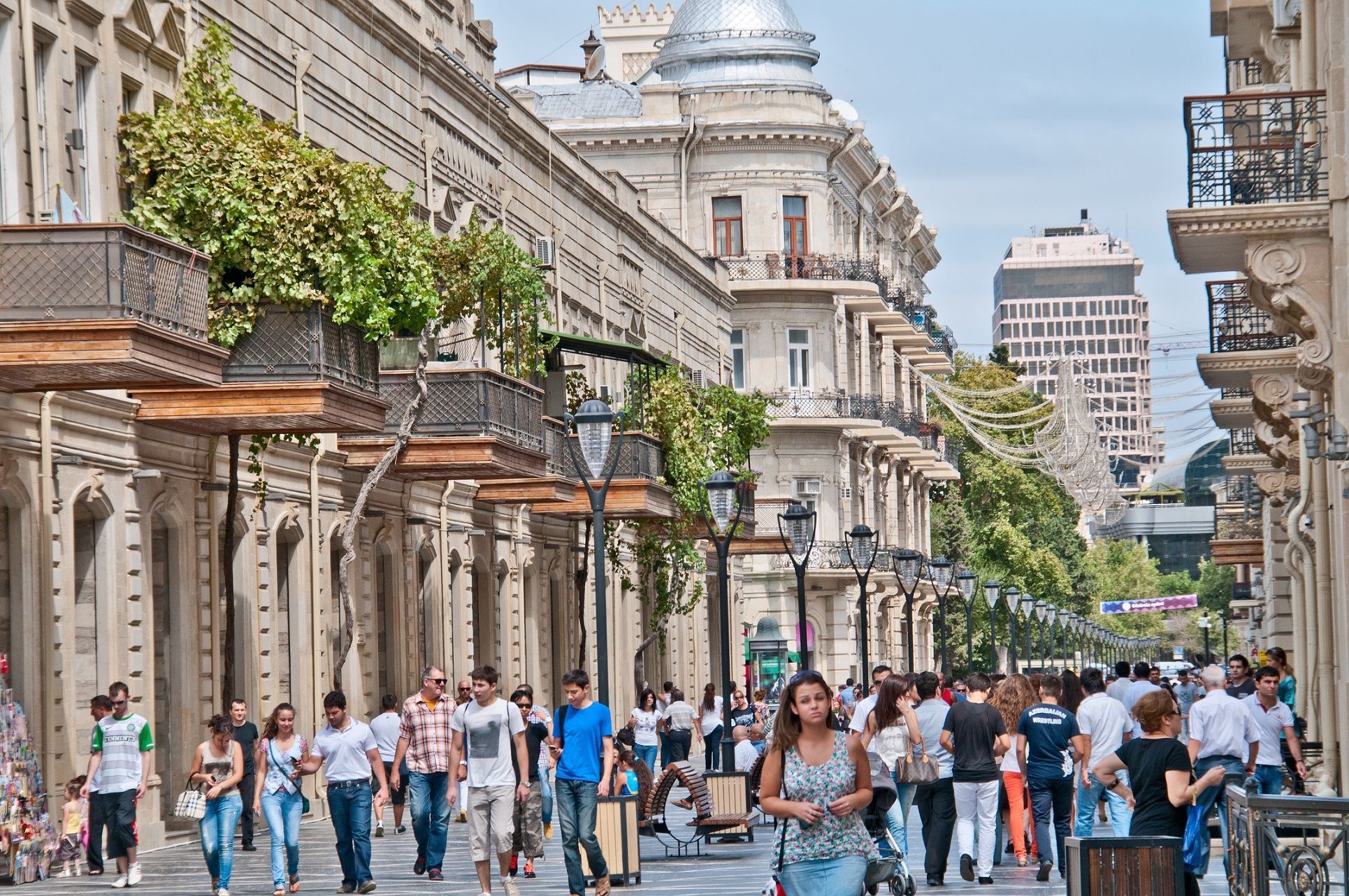 Azerbaijan
Azerbaijan
Azerbaijan in DepthFrom : $ Please requestDiscover : Baku * Guba * Lenkaran......Includes :• All Transfers with a Journeys Rep• Accommodation of 14 Nights with B/fast• Services of an English speaking Guide• Entrance fees, wherever applicable• Private A/c Transport• 24/7 Assistance• Farewell Gift -
 Azerbaijan
Azerbaijan
Hello BakuFrom : $ Please requestDiscover : BakuIncludes :• All Transfers with a Journeys Rep• Accommodation of 6 nights with B/fast• Services of English speaking Tour-guides• Entrance fees, wherever applicable• Private A/c transport• 24 / 7 Emergency Support• Farewell Gift -
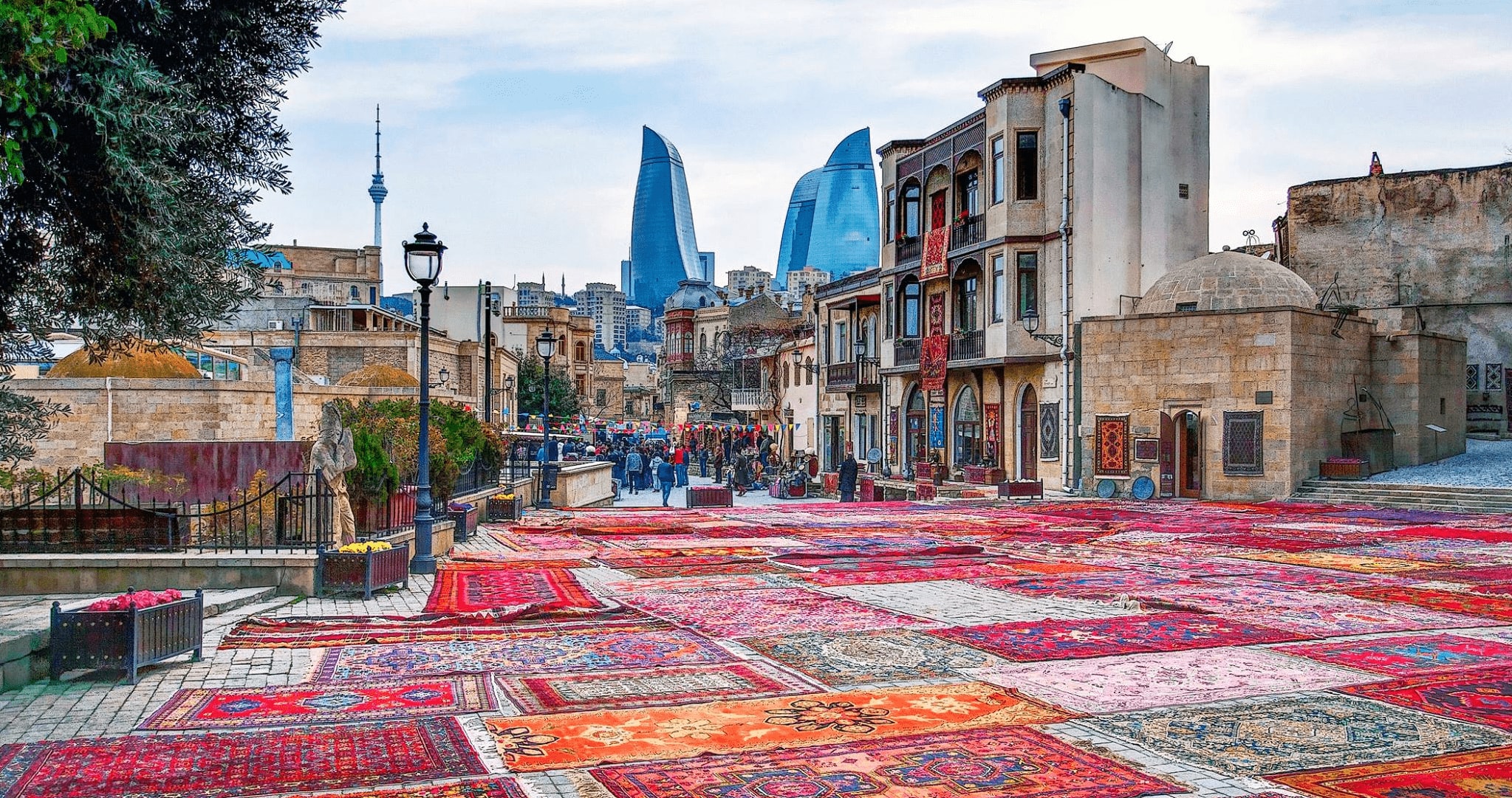 Azerbaijan
Azerbaijan
Carpet Trail on the Silk RouteFrom : $ Please requestDiscover : Baku * Lahic * Samaxi......Includes :• All Transfers with a Journeys Rep• Accommodation of 9 nights with B/fast• Services of English speaking Tour-guides• Entrance fees, wherever applicable• Private A/c transport• 24 / 7 Emergency Support• Farewell Gift -
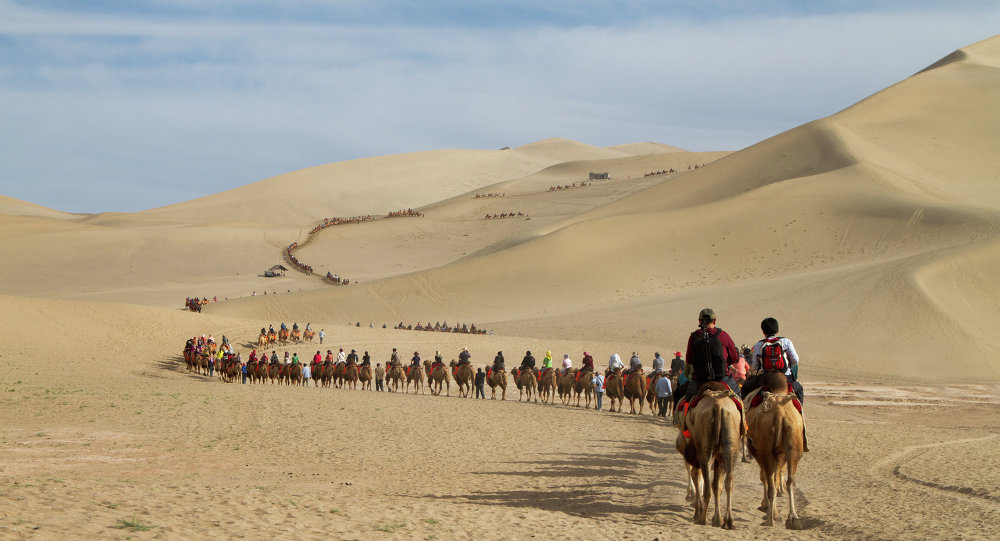 Azerbaijan
Azerbaijan
Azerbaijani KaleidoscopeFrom : $ Please requestDiscover : Baku * Absheron * Gabala.......Includes :• All Transfers with a Journeys Rep• Accommodation of 14 Nights with B/fast• Services of an English speaking Guide• Entrance Fees• Private A/c Transport• 24/7 Assistance• Farewell Gift -
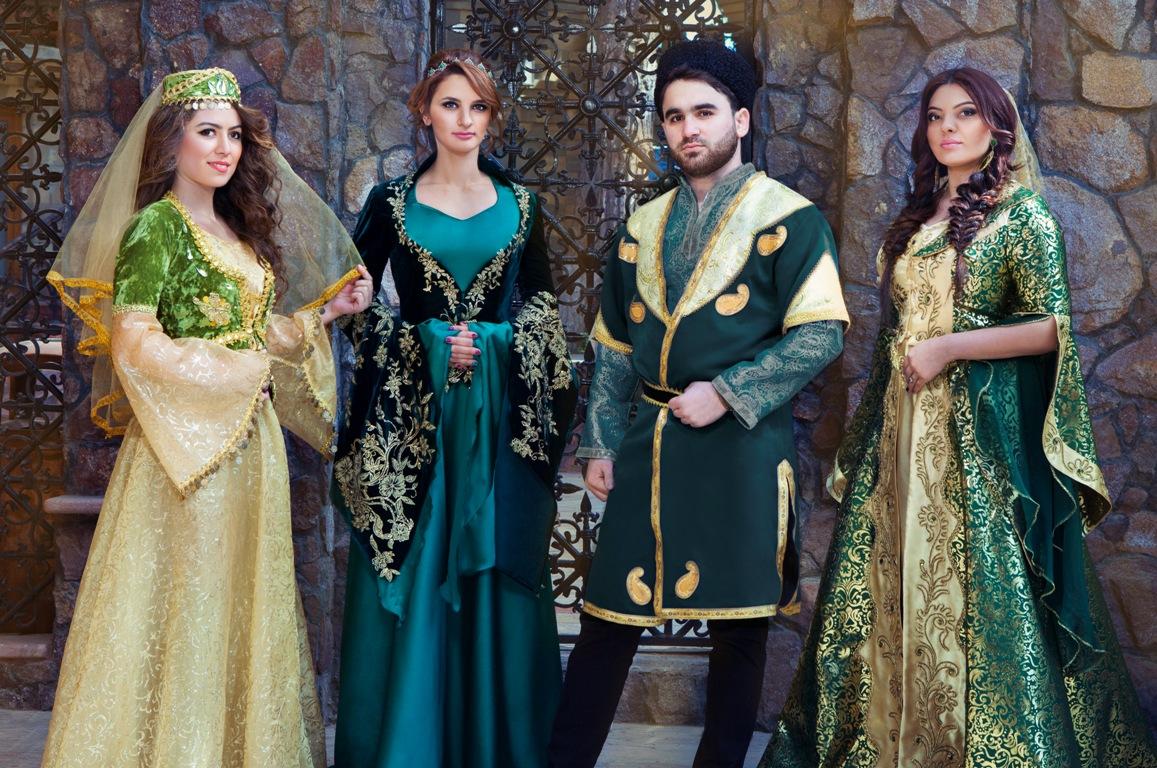 Azerbaijan
Azerbaijan
Ladies on the Silk Route in AzerbaijanFrom : $ Please requestDiscover : Baku * Lahic * Samaxi......Includes :• All Transfers with a Journeys Rep• Accommodation of 14 nights with B/fast1• Services of English speaking Tour-guides• Entrance fees, wherever applicable• Private A/c transport• 24 / 7 Emergency Support• Farewell Gift

Thank you.
alttag
- Overview
- Itinerary
- Inclusion
- Hotels
- Rates
- Information

Azerbaijan… waiting to be discovered…
Azerbaijani Kaleidoscope
The word is out: as far as off-the-beaten-path destinations go and if you fancy travelling somewhere neither East nor West, and exotic & fascinating yet perfectly comfortable then, Azerbaijan might just be one of the most rewarding destinations on Earth.
History within history is probably the best way to describe this journey. The epicenter of a 21st century oil boom, Azerbaijan sits on the western Caspian Sea shore & here, travelers can stay in a glass & steel luxury hotel, yet still experience the classic vividness of Azerbaijani hand loomed carpets & the mesmerizing music of mugham, its chanting melodies passed from ear to ear over centuries. On this 2 week journey, you will experience a bit of everything Azerbaijan has to offer......
From the nomadic steppes of Kazakhstan to the frenetic streets of Hanoi, Asia is a continent so full of intrigue, adventure, solace and spirituality that it has fixated and confounded travellers for centuries.
Asia has contributed a cast of villains & heroes to global history. Most of the significant achievements of the modern world had their infancy in Asia. Historic trading routes sliced across epic terrain as expanding empires competed to trade goods & ideas throughout the continent and beyond. Asia’s ambitious civilisations ultimately gave rise to some of the world’s most revolutionary ideas & important technology. Ancient wonders & sacred spaces abound across the continent, from the Great Wall of China and the temples of Angkor to lesser-known marvels in Myanmar, Nepal & Afghanistan.
From sublime coastlines to snow-capped mountains, the majestic Mekong River to wildlife infested jungle, Asian landscapes hold an immediacy & vibrancy that captivates and enchants. Immense expanses of desert flow down from inhospitable mountains, which in turn give way to seemingly impenetrable forests. In a land where tigers still roam free (though far from noisy tourists) nature continues to be the driving force in many peoples’ lives. Virtually every climate on the globe is represented here; take a trek over the Gobi’s arching dunes or sun yourself on the sand-fringed tropical islands of the South China Sea.
The unmoving landscapes of the Silk Road have enchanted travellers for millennia. The Great Silk Road is the name of an ancient transcontinental trade trunk route, that once integrated the East & the West. Few people know that the western world got to know about China, one of the most mysterious countries of antiquity, through the advent of the Great Silk Road. It was the road by which silk & other goods, unknown in Europe before, began being exported to the Western countries in the 2nd century BC. Novelties like cotton, dates, cucumber, various melon & gourds, and citrus cultures, china & ivory were brought by this road. The Road was also a connecting link to exchange ideas & cultures and was used to bring paper & gunpowder from China to the West.
This was the road Marco Polo made a voyage by, discovering mysterious China to the Europeans. And the road that was used by Atilla & Genghis Khan to lead their armies.
The Silk Road has existed for thousands of years, passing through many different empires, kingdoms, reigns & societies throughout history. In the antiquity & Middle-Ages, it was also a channel to disseminate scientific knowledge & cultural values and it was the way the Buddhist monks were moving by, disseminating their teaching around the world, when Buddhism came from India to China & Central Asia.
At certain times in its long history, traders could travel freely along these routes, whereas at others, travel was difficult or dangerous. The Silk Road enriched the countries it passed through, transporting cultures, religions, languages & of course, material goods into societies across Europe, Asia & Africa, and uniting them all with a common thread of cultural heritage & plural identities and historic value have been developed in different regions alongside the Silk Roads. Each of these sites or monuments not only represents the various customs & traditions of local communities, but also bears witness to the cultural interaction that took place in or around them, revealing the influence of cultures from around the world, brought into contact via the historic Silk routes.
Cities grew up along the Silk Roads as essential hubs of trade & exchange and after travelling for weeks on end, across inhospitable deserts & dangerous oceans, they provided an opportunity for merchants & their animals to rest, to sell & buy, and moreover, to meet with other travellers, exchanging not only material goods but also skills, customs, languages & ideas. In this way, over time, many Silk Road cities attracted scholars, teachers, theologians & philosophers, and thus became great centres for intellectual and cultural exchange & building blocks in the development of civilizations throughout history.
From Xi’an in China to Bukhara in Uzbekistan, from Jeddah in Saudi Arabia (then, the region of Hejaz) to Venice in Italy, cities supplied the ports & markets that punctuated the trade routes & gave them momentum.
Travelling the length of this route today, with its flaming red mountains, towering sand dunes & alpine lakes, still offers a very real sense of what ancient traders experienced. And in 2014, UNESCO listed the entire 5000 km Tian Shan Corridor as a World Heritage Site.
There are over 40 countries today alongside the historic Land & Maritime Silk Roads, all still bearing witness to the impact of these routes in their culture, traditions & customs.
One of them is Azerbaijan, a former Soviet republic, bounded by the Caspian Sea & Caucasus Mountains, which span Asia & Europe.
Selling itself as the 'Land of Fire', Azerbaijan is a tangle of contradictions & contrasts. Neither Europe nor Asia, it is a nexus of ancient historical empires, but also a ‘new’ nation rapidly transforming itself with a super-charged gust of petro-spending.
The cosmopolitan capital, Baku, famed for its medieval walled Inner City, is a UNESCO listed ancient core with dazzling 21st century architecture & sits on the oil-rich Caspian Sea. Within the Inner City, lies the Palace of the Shirvanshahs, a royal retreat dating to the 15th century, and the centuries-old stone Maiden Tower, which dominates the city skyline.
In the surrounding semi-desert are mud volcanoes & curious fire phenomena. Yet barely three hours’ drive away, timeless rural villages, clad in lush orchards & backed by the soaring Great Caucasus mountains are a dramatic contrast.
In most such places, foreigners remain a great rarity, but in return for a degree of linguistic dexterity, you will find a remarkable seam of hospitality. And a few rural outposts - from village homestays to glitzy ski & golf-hotels - now have the odd English speaker to assist travellers.
History, great food & idyllic scenery are just the beginning……. Take the plunge now and yep….Azerbaijan on the Great Silk Road is waiting. A warm welcome, historical secrets & an artistic paradise awaits you and The Journeys is ready to take you on well, a journey (or journeys) of discovery.
Come…be inspired & discover theWorld with us
|
Azerbaijani Kaleidoscope |
||
|
Day | Date |
City |
Transfers | Sightseeing |
|
Any Day |
|
|
|
01 | |
Baku |
✈ Arrival Transfer | Free (balance of the day) |
|
02 | |
Baku |
AM | PM Baku | Free (balance of the day) |
|
03 | |
Baku |
AM Gobustan National Park | PM Ateshgah Temple | Free (evening) |
|
04 | |
Gabala |
AM vTransfer | PM Gabala | Free (balance of the day) |
|
05 | |
Gabala |
AM | PM Sheki City | Free (balance of the day) |
|
06 | |
Gabala |
AM | PM Ganja City | Free (balance of the day) |
|
07 | |
Baku |
AM vTransfer | Free (balance of the day) |
|
08 | |
Guba |
AM vTransfer + Qusar | Free (balance of the day) |
|
09 | |
Guba |
AM | PM Guba | Free (balance of the day) |
|
10 | |
Baku |
AM vTransfer | Free (balance of the day) |
|
11 | |
Lankaran |
AM vTransfer + Masali | Free (balance of the day) |
|
12 | |
Lankaran |
AM Lankaran | PM Lerik | Free (balance of the day) |
|
13 | |
Baku |
AM vTransfer | Free (balance of the day) |
|
14 | |
Baku |
AM Baku | Free (balance of the day) |
|
15 | |
Baku |
Departure Transfer ✈ |
|
|
||
|
|
|
|
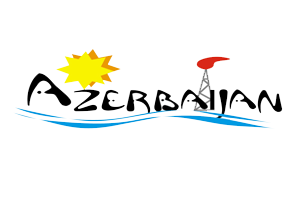
![]()

Mystical Azerbaijan…experience is now……
Azerbaijani Kaleidoscope
Baku * Absheron * Gabala * Shaki * Ganja * Gusar * Guba * Masalli * Lenkaran * Lerik * Baku
15 Days | 14 Nights
Day 1 - Arrive ✈ Baku at ????
Welcome to incredible Azerbaijan - a tangle of contradictions & contrasts, billing itself as the 'Land of Fire’. Neither Europe nor Asia, it' is a nexus of ancient historical empires, but also a ‘new’ nation which has undergone an extraordinary transformation from the war-ravaged post-Soviet 1990s to an oil-enriched host of Formula 1 & Europa League football.
Arrive in cosmopolitan capital, Baku, the gateway to an ancient world capital city.
After you exit in the Arrival Hall at Terminal? - Baku Heydar Aliyev International Airport, subsequent to Customs & Immigration, you will be welcomed by The Journeys representative who will ensure your comfort & transfer you to the hotel, help you settle in & provide you with some useful tips for exploring the area as well as discuss the program for the next couple of days.
Reach the hotel & Check-in.
*Check-in time is 02.00 pm. For earlier arrivals in the morning, we will request the hotel for a complimentary early Check-in but cannot be guaranteed unless reserved & paid for ‘immediate occupancy’.
Breathtaking Antiquity | Architectural Masterpieces | Soviet Reminiscence
Azerbaijan’s capital, the port city of Baku with its UNESCO World Heritage listed medieval Old City (İçəri Şəhər) contrasting with dazzling 21st century architecture, lies on a balmy bay of the Caspian Sea.
Baku is the cultural & commercial hub of the country and is denoted as an architectural love child of Paris & Dubai…albeit with plenty of Soviet genes floating half-hidden in the background. Few cities in the world are changing as quickly and nowhere else in Eurasia do East & West blend as seamlessly or as chaotically. Yet barely 3 hours’ drive away, timeless rural villages lie amid lush orchards backed by the soaring Great Caucasus Mountains.
At its heart, the medieval Old City lies within an exotically crenelated arc of fortress wall & which contains the Palace of the Shirvanshahs, a vast royal complex & the iconic stone Maiden Tower.
Around this, are gracefully illuminated stone mansions & pedestrianised tree-lined streets filled with exclusive boutiques. In the last decade, countless towers have mushroomed, dwarfing or replacing tatty old Soviet apartment blocks. Some of the finest new builds are jaw-dropping masterpieces. Contemporary landmarks include the Zaha Hadid - designed Heydar Aliyev Center & the Flame Towers - 3 pointed skyscrapers covered with LED screens.
Meanwhile romantic couples canoodle their way around wooded parks & hold hands on the Caspian-front bulvar (promenade), where greens & opal blues make a mockery of Baku’s desert-ringed location.
Baku is the largest cultural centre of Azerbaijan. It is the place where a national theatre, the first in Muslim East, lifted the curtain, the first opera was performed, the first Azerbaijan newspaper was published, the first Azerbaijan library was opened. Today Baku is known to have 30 museums, 7 theatres, 11 institutions of higher education, philharmonic, opera theatre, film studio, cinema theatres & libraries housed in the city’s most beautiful buildings having an interior decoration which is every bit as good as their interior cultural content.
No services are envisaged today.
However, if time permits & you wish to explore independently, we shall be only too happy to offer suggestions.
Overnight. D
Day 2 - Baku
Morning, meet your Tour-guide in the lobby at 09.00 am to proceed for a 8 hour sightseeing tour of the city.
With your knowledgeable, talkative, sociable Tour-guide explaining about the culture, history & other interesting facts about Baku, you will visit different parts of city relating to various historical periods starting from middle ages to modern era.
Visit the main historical side of Baku, stopping at the UNESCO Heritage listed Old Town or Walled City.
Stop at the 12th century Maiden Tower & Juma Mosque, 15th century Shirvanshahlar Palace in the Museum complex 14th century Caravanserais, Mosques, Baths & the market square.
Break for lunch (not included - direct payment). You will not want to miss the chance to taste delicious, mouth-watering, traditional ethnic food in the authentic restaurants - Kebabs, Gutabs, Pastry etc.
Post lunch, you will pass by Flag Square which is home to the world's second tallest flagpole, according to the Guinness Book of Records, Carpet Museum - a treasury of Azerbaijan national culture, established for researching, keeping & displaying carpets and carpet items, as well as applied art works, The Museum has the largest collection of Azerbaijan carpets in the world, of different weaving techniques & materials; Government House and the building which held the first casino in the Caucasus, Azerbaijan State Philharmonic Hall, Old City Hall & stop at the "Governor's garden".
Drive by Fountain Square - a tony area filled with the 19th century mansions of the ‘old money’ oil magnates, Opera House, Musical Theatre & National Library.
You will also have the opportunity to stop at the Bibi-Heybat Mosque, one of the major monuments of Islamic architecture in Azerbaijan. The existing structure, built in the 1990s, is a recreation of the mosque with the same name built in the 13th century by Shirvanshah Farrukhzad II Ibn Ahsitan II, which was completely destroyed by the Bolsheviks in 1936. Today it is the spiritual centre for the Muslims of the region and the modern restored mosque is a classic example of the Shirvan architectural school, having three domes decorated with green & turquoise mirrors, which are bordered with gilded inscriptions from the Qur’an.
Finally, drive along the seaside boulevard, passing by Upside Hill, Martry's Alley & Mosque, Turkish Alley, Flame Towers & enjoy the panoramic view of Baku.
The tour concludes & you will return to the hotel.
Overnight. B
Day 3 - Baku v Gobustan National Park v Baku Drive: 60 km x 2
Morning, meet the Tour-guide in the lobby at 08.00 am to proceed for a 8 hour sightseeing excursion to visit Gobustan National Park.
Explore Gobustan National Park, officially known as the Gobustan Rock Art Cultural Landscape. On an area of 537 hectares, there is one of the world's largest ancient petroglyphs collections counting more than 4,000 petroglyphs.
The park is actually a hill & mountain site at the southeast end of Azerbaijan’s Greater Caucasus mountain ridge.
First you will visit new & modern Gobustan Petroglyph Museum with various exposition halls. You will see ancient human bones & work tools that were used thousands of years ago during the Mesolithic period.
Later, drive high up the mountain where the stones with petroglyphs are located. At the mountain site, see rock paintings & carvings in an open-air museum. These primitive monuments of art reflect the culture, economy, world outlook, customs & traditions of the ancient Azerbaijani peoples.
Once there, you feel yourself back in Stone Age and get unforgettable memories that you cannot get anywhere else.
In the Gobustan National Historical-Artistic Reserve, one can see the settlements of the ancient people, the remains of the large prehistoric Stone Circle & other evidences of the Stone Age & later inhabitants of the region. See the ancient rocky paintings, camp of man, tombstones & more. The most significant rocky pictures are the petroglyphs, carved by primitive peoples on the walls of caves, rocks and on stony lumps.
UNESCO World Heritage Listed Gobustan petroglyphs were repeatedly investigated by the famous Norwegian explorer and adventurer Thor Heyerdahl, who recognized local boats petroglyphs as the oldest known images of pirogue in the world. These vessels, similar to the old Scandinavian ships, prompted him to make sensational hypothesis statement about the connection between Norwegians and Azerbaijanis. Thor Heyerdahl concluded that the ancestors of the Scandinavians were the migrants from Azerbaijan region.
Of special interest of the tourists is also a stone slab with a Latin inscription dated by the first century. The stone lab was left here by XII Roman legion of the Emperor Domitian, which indicates that legion had stayed here.
The next destination will the nearby active Mud Volcanoes Azerbaijan is known for, weather permitting. There are approximately 350 volcanoes located on shore, sea & islands. Rich oil & gas fields have been discovered in the vicinity of these mud volcanoes of Lokbatan, Garadgh, Neft Dashlari, Mishovdagh & others.
In addition, lava, mud & liquid that has erupted from the volcanoes is used as raw materials in chemical & construction industries as well as pharmacology.
On the way back to the city, you will visit the Baku Ateshgah or "Fire Temple" is a Zoroastrian or Hindu castle-like religious structure in Surakhani, a suburb on the outskirts of Baku.
Baku, over thousands of years, opened its gates to millions of people from different corners of the world & became a homeland for these ancient tribes & nations.
Ateshgah is a karavanserai-shape fire temple of Zoroastrians who lived in Azerbaijan for centuries. Because of location on the road of Great Silk Way, a lot of merchants passed through the "land of fire" over the course of history & some settled here. "Atash" is the Persian word for fire. The pentagonal complex, which has a courtyard surrounded by cells for monks & a tetrapillar-altar in the middle, was built during the 17th & 18th centuries. It was abandoned after 1883 when oil & gas plants were established in the vicinity, ending the flow of natural gas to the temple & extinguishing the holy fire.
The Baku Ateshgah was a pilgrimage & philosophical centre of fire worshippers from Multan (Pakistan), who were involved in trade with the Caspian area via the famous "Grand Trunk Road". The four holy elements of their belief were: ateshi (fire), badi (air), abi (water) and heki (earth). The temple ceased to be used as a place of worship after 1883 with the installation of petroleum plants at Surakhani. The complex was designated as a Museum in 1975.
Make another stop at Qala Archaeological & Ethnographic Museum Complex before returning to the hotel.
The Qala Complex is mandated to preserve the monuments & archaeological finds discovered in Absheron region. Petroglyphs covering the period from the 3rd & 2nd millennia B.C. to the Middle Ages, gavaldash (tambourine stone), domestic ceramics items from 10th - 16th centuries, adornment items like the remnants of a golden bracelet, weapons, gold coins, conserved remnants of an ancient residential complex etc. found in the Absheron peninsula, are displayed at the Complex.This open-air park features several furnished traditional-style Abşheron buildings (house, smithy, potters workshop) set amid a wide range of archaeological finds & petroglyphs, both originals & designed.
Historic little Qala is dominated by a ‘faux ‘fortress monument relating to the 14th century Fortress & includes a 13.8 meters tall tower used for surveillance & defence.
You will also come across local artisans demonstrating & immortalizing the traditions of textile, pottery & copper-smithery. Master classes are organized for children & representatives of the young generation are given an opportunity to become acquainted with old household & ethnographic traditions.
Here, you may learn to bake bread, weave, iron forge from professional masters for extra payment (optional - extra payment).
Finally, the sightseeing comes to an end & you are transferred to the hotel.
Overnight. B
Day 4 - Baku vGabala Drive: 219 km
Morning, depart for Gabala
Gabala, is one of the most beautiful parts of Azerbaijan with a rich and ancient history. There is a great number of historical & cultural monuments of different eras in this region.
Sometime in the past this city (Kabbalah) was the capital of Caucasian Albania for 600 years, mentioned in the works of antique historians of the 1st century. Later in the Arabian sources, it was mentioned as Khazar. Up to this present time there are the ruins of the ancient city and the main gate of Caucasian Albania. Ongoing excavations near the village Chukhur confirm that Gabala from 4th - 18th centuries was one of the major cities with developed trade and crafts.
At first Gabala was a part of Shirvanshahs state & later Sheki khanate. The city was repeatedly exposed to devastating invasions. But despite this, Gabala has preserved material evidence of its civilized past.
The ruins of ancient Gabala are a short distance away from the present day city but the excavation finds from the ancient settlement can be seen in the City Museum. The area around Gabala also boasts of numerous historical & architectural monuments amidst the ruins of an ancient city said to be about 2,000 years old.
There is the Nij village inhabited by Udi, direct descendants of the ancient Caucasian Albanians. Among the local attractions there, are the famous 500-year-old nut & chestnut forests - so called Russian forests, river valleys & numerous picturesque villages. Blooming chestnuts are a unique sight in the spring time.
Flora & fauna of the district are extraordinary rich: in the woods & mountain pastures can be found noble deer & wild boar, hare, bears, wolves, foxes and numerous birds - pheasant, grouse, francolin, etc. The abundance of game in the season attracts many hunters.
Gabala also boasts of the largest open air amusement park in Azerbaijan - Gabaland covering an area of 16 hectares. The town also hosts an annual International Music Festival of classical music, jazz & mugham, which is attended by bands & artists from all around the world. Not surprisingly that exactly in Gabala, is located a factory for piano manufacturing under the famous Dutch brand Beltman.
On arrival by early afternoon, Check-in at the hotel.
Overnight. B
Day 5 - Gabala vSheki vGabala Drive: 90 km x 2
Morning, meet the Tour-guide at 08.00 am & depart for a full day 8 hour excursion to Sheki City, close to Georgian border.
Few foreigners visit Azerbaijan beyond its capital city of Baku. In so doing, they overlook a true gem in the form of Sheki.
A relatively small city, Sheki is set in a picturesque setting - it lies in the rolling, thickly forested foothills, which spread out to the south, while to the immediate north are the dramatic, snow-capped peaks of the Greater Caucasus - a mountain area rich in narrow gorges & green valleys, springs, purest rivers, waterfalls & mineral water springs framed by dense wood & alpine meadows.
But more than anything, the relaxed pace of life evident in Sheki's central market and tea houses makes the city a welcome respite from whatever cares may trouble you. Rich in Islamic architecture, Silk Road history, good food & friendly people, this is travel & leisure in the Caucasus at its finest. Sheki has its own theatre, a historical museum, the house-museum of the Azerbaijan writer & philosopher M.F. Ahundov.
Throughout its history, Sheki swung between independence & foreign domination.
In earlier centuries, Sheki was the seat of an Albanian kingdom, which was invaded repeatedly by the Persian, Roman, Parthian, Arab, Mongolian & other empires. In the past millennium, Sheki fell under the influence & often the direct rule of Persia or the Shirvanshahs of Baku. Shortly after the 18th century collapse of the Safavid Empire, Sheki became the capital of the independent Sheki Khanate, during which the Khansarai was built. But Sheki's independence did not last long; it was absorbed in the early 19th century by an expansionist Russian Empire.
Archeological data testify that the city can be considered one of the oldest settlements in the Caucasus; many finds on its territory are dated as old as 2,500 years. Due to Sheki's rather tumultuous political history (in a turbulent region), the majority of Sheki's preserved historic & architectural monuments date from only the 16th - 19th centuries.
In addition to enjoying the views & wandering the leafy streets, there are two sights in Sheki that you really cannot miss: the Khansarai & the Caravansarai. .
The city can boasts many historical & architectural places of interest, but its pride is that magnificent work of Islamic architecture, UNESCO World Heritage Site of Khansarai - the 18th century majestic royal palace of Sheki Khans with its magnificent wall paintings & tracery windows in the stone citadel. During the city's period of independence as the Sheki Khanate, Khan Hussein constructed the palace, its gardens, and fortifications to serve as the summer palace of the Sheki Khans. The palace is exquisite, inside & out, and the courtyard boasts panoramic views of the city & the surrounding mountain forests. It is said that during the construction of the palace, not a single nail was used. You can hardly find another palace like this.
The other ‘must-see’ located close by is the Caravansarai, constructed by the Sheki Khans to house caravans as they passed through on the Silk Road to & from China.
Sheki was famous as the city of craftsmen & merchants. Merchants & traders from the countries of the Great Silk route used to gather there. Therefore, a great attention was paid to construction of caravanserais. Caravanserais were built with a view of all convenience & safety of merchants & their goods. In Sheki caravanserais merchants stored their goods in cellars, traded on the first floor, and lived on the second. Each floor had more than 200 rooms. According to the tradition caravanserais had two & even four entrances. When closed, caravan serais turned into fortresses. This was one of 5 such stops in Azerbaijan during the 18th & 19th centuries, and was the biggest caravansarai on the Silk Road in the entire Transcaucasus region. Only two of them have survived.
To this day, The Upper caravanserai (floor) still serves as a place for travellers to stay & eat (in addition to being a main sight, it is also one of the city's few hotel options), and also as a place where one can simply admire its beautiful architecture.
You will also be visiting the picturesque 18th century Juma Mosque decorated with exquisite geometric designs & with its 40m spire, from which you will hear the resounding call to prayer 5 times a day.
Sheki, in addition to being on the Silk Road, has itself been a major silk producer over the past four centuries & is famous for its various silk products. Sheki's silk factory is about a 15 minute walk from the centre of town. However, it is quite difficult to gain entrance into the factory but there is a store adjoining the factory, where vendors sell very fine silk items at high prices.
Sheki is a major center of crafts. The city still has street names that indicate the ancient professions - Duluzchular (potters), Zargarlar (jewelers), Halvachylar (confectioners), etc. By the way, be sure to try the famous, mouth-watering Sheki baklava, which is manufactured and sold in numerous family confectionary stores in the city center. You can buy jewels & engravings by local craftsmen.
There are numerous unique monuments of history that have survived, scattered around Sheki. Among those are the 18th century “Kyumbazi” Towers in Kutkashen, Sumug Fortress & a mosque in Ilisu, a Fortress & Kish Mausoleum, a 4th century Fortress in Ukhary -Chardahlar & numerous ruins. Depending on the available time, you might visit a couple of those.
Return to the hotel.
Overnight. B
Day 6 - Gabala vGanja vGabala Drive: 160 km x 2
Morning, meet the Tour-guide at 07.00 am & depart for a full day 8 hour excursion to Ganja
The 6th century city of Ganja is located at the foot of the Minor Caucasian Ridge, on the Gjandzhachaj river. In the first half of the 7th century, it was destroyed by Persians and in the second half by Arabs.
In the middle of 10th century Ganja became the capital of Shadadit - one of the smaller khanates on the territory of Azerbaijan and then it was conquered by the Seljuks. In 11th century, there was a major earthquake which destroyed the city & led to the disintegration of Seljuk state. But, as an after effect, a number of picturesque lakes were formed: Lake Gek - Gel, Lake Maral-Gel, Lake Dzheran-Gel, Lake Ordek-Gel & more, among them.
The city was rebuilt & Ganja became the second capital of Atabek state in 12th century and in 18th century, it became the center of Ganja Khanate. In 1804 Ganja Khanate was occupied by Russian armies, and Ganja was renamed Elizabethpol. During Soviet time, Ganja was renamed again into Kirovabad and was the second biggest industrial & cultural city in Azerbaijan after Baku. It reverted back the original name, after independence was won by Azerbaijan in 1991.
Owing to the centuries-old history, the city became the location of numerous historical & architectural monuments with strongly pronounced Azerbaijan national color.
Among the surviving landmarks are the 14th - 17th centuries Gei-Imam cult complex, the 17th century Djuma Mosque, a variety of picturesque old houses, well-known stone sculptures of horses & other pets.
First stop will be at the Goygol National Park.
The Park is intended to protect the natural ecosystem of the area includes one of the most beautiful and cleanest lakes in Azerbaijan, Lake Goygol. The area is almost entirely covered by forests & has a rich flora & fauna with over 420 plant species, including 20 which are endemic to the area.& there are fruit trees such an apple, pear, cherry & plum, too. There are several endemic subspecies of birds, of which the bearded vulture, Egyptian vulture), Eurasian eagle-owl, black woodpecker, golden oriole, mistle thrush to name a few.
The Caspian tiger once roamed these mountains, but is now extinct. Other large mammals here are the lynx, brown bear, wild boar, wolf, golden jackal, jungle cat, red fox, roe deer, badger etc. The Persian leopard subspecies of the leopard, lives in the southern regions in Azerbaijan, primarily in the Talysh Mountains, Nagorno-Karabakh & Nakhichevan regions. However it is still not clear if leopards live in the Göygöl National Park.
Spend an hour in the picturesque surroundings & continue on to the city.
Proceed on a walking tour, visiting the UNESCO listed Mausoleum of medieval Azerbaijani poet Nizami Ganjavi. There is 20 metre tall marble monument which has cast iron figures depicting scenes from Nizami poems. There is also a museum, art gallery, theater of poetry named after Nizami.
You will also see a very unique Bottle House, a two-storey building constructed of approximately 50,000 bottles, built by Ibrahim Jafarov in 1966 in honor of his brother missing in the Great Patriotic War.
Very popular with locals & visitors, are Ganja’s many picturesque alleys & parks, the largest & most beautiful of which is “Khan Baghi” (“Khan’s garden”), named so in the reign of Javad Khan (1748 -1803). Recently, the Park was renovated & as if shaking off its venerable age, has become younger and now boasts fountains with a modern lighting system, cafes, a theater and also birds: peacocks, white swans & pink flamingos.
Among the ancient monuments are: the big & small 12th century bridges & the palace of Sultan Darus numerous towers, madrasas, baths & caravanserais.
There are also several ancient mosques. You will see one of the most important, the central Juma (Shah Abbas) Mosque, A prominent Azerbaijani poet Vazeh taught for a long period at the madrasa in the Juma Mosque.
City baths are very notable by their striking colors and attractive domes. The ancient Chokak Bath was restored recently & now again functions as a traditional hamam.
Visit the Mausoleum of Sheikh Ibrahim preserved its original beauty, the restored Shah Abbas Caravanserai that has been converted into a modern hotel; See the near-by Tomb of Javad Khan.
Stop at the magnificent religious & historical 14th century "Imamzade" complex with its blue domes. It is said that the son of 5th Imam Mohammad Baghir Ibrahim was buried there.
There are also some beautiful churches, the 17th century Armenian Church, 15th century Caucasian Albanian Church which is now used by the Ganja State Philharmonic Chamber;
Finally the tour comes to an end & you drive back to the hotel in Gabala.
Overnight. B
Day 7 - Gabala vBaku Drive: 219 km
Morning, depart for Baku.
On arrival, Check-in at the hotel.
Overnight. B
Day 8 - Baku v Qusar vGuba Drive: 180 km
Early morning, depart for Guba, enroute stopping at Qusar.
Qusar is located not far from Bazarduzu, Shahdagh Mountains & the Russian border. Only in 1938, Qusar settlement acquired a city status. There exist many versions about origination of the city, but the most possible one is a version of Tamilla Khalilova, a notable historian.
According to historical data, the Arabs began a conquest of the South Caucasus in the 7th century & reached a territory of present Qusar Rayon.
According to the historians’ version, the name of the river originated from Arabian Al-Qausar. In translation from the Holy Quran into English “Al Qausar - in translation, means a river of abundance, that is a heavenly river, water of which is whiter than milk & sweeter than honey. Its fragrance is nicer than musk & birds with beautiful long necks like necks of camels fly around it.” The settlement got its name from the river - Qusar
There is a museum & an impressive new Turkish-style mosque but the ruins of Qarabulaq offer the only intriguing sight.
Qarabulaq was a 21st century holiday retreat, designed with lots of brilliantly idiosyncratic Tolkein-esque twiddles, including concrete knights brandishing flame-throwing weapons. Then, in 2005 authorities discovered that the location had been used for criminal activities & was promptly closed down. Now, creepers are slowly overrunning its eclectic buildings and this adds further to the already bizarre atmosphere.
Stop at the ethnic Laza Village, located in a mountain hollow in height 1300 m, on the ancient caravan routes across the passage of the Main Caucasian Ridge.
The soaring mountain valley surrounding Laza is one of the most stunning sights anywhere. Dramatic grass-clad slopes descend from noble Shahdag (4243m) and craggy Qyzylqaya (3726m). A series of ribbon waterfalls drop over perilous cliff edges & carpets of wildflowers add to the vivid greens throughout late spring & summer
The tiny village is diffuse & its banal houses lack the striking austerity of Xynalyq’s dark stone architecture. The vicinity of the village is very picturesque, numerous waterfalls flow down from rocky walls. A rocky pinnacle beside the rusty-roofed little mosque adds foreground for photos of the mind-blowing mountain panorama.
In the ancient village, live ethnic Lezghins whose history is connected to the Caucasian Albania - one of the most ancient states in the territory of Azerbaijan.
During the centuries, there was a gradual movement of a part of the Lezghin tribes to southern, foothill & aound the Caspian zones. It is important to note that the historical destiny of the Lezghin people is closely related to Azerbaijan & the Azerbaijani.
Inhabitants of the village live a usual life of high-mountainous settlements, conduct housekeeping, and hold birds, large horned and fine horned livestock. In summer they drive away the herds on high-mountainous pastures "Shah Yaylag" and "Shah Nabat".
Inhabitants talk to each other in the native Lezghin language. They freely communicate with visitors in the Azerbaijan language. Many middle-aged men speak Russian adequately. Schoolboys study the English language since recently has grown the stream of the foreign tourists making ascensions on the highest plateaus and tops "Shahdag", "Gizil Gaya", "Tufan", "Bazar-Duzu", etc.The settlement consists of 26 houses, which about 130 inhabitants live in. There is a school with 4- year-education.
Continue on to Guba
Quba located in the picturesque hillsides, is one of the largest cities in Azerbaijan. It was once the capital of Quba khanate which was founded in the mid18th century. Indeed, the sceneries of Quba are hard to describe with words. It seems nature has collected there the brightest colors: juicy greens of the alpine meadows, white snow caps, rapid transparent-blue mountain rivers. The symbols of Quba are the apple orchards & beautiful Quba carpets, which are popular outside Azerbaijan, too.
Reach Guba & Check-in at the hotel.
Overnight. B
Day 9 - Guba
Morning, meet the Tour-guide at 09.00 am & proceed for a 6 hour sightseeing tour of Guba & its surroundings.
You will visit some of the main landmarks here. The 19th century Dzhuma Mosque whose construction is typical only for the mosques of Quba province. Inside there is a big hall crowned with a huge 16 metre diameter dome.
Next stop is the Sakina-Khanum Mosque built in 1854 by the widow of A. Bakikhanov - the well-known Azerbaijan scientist & writer to commemorate her late husband. The red brick building is designed like a faceted cylinder. Each facet has a window in the form of a semicircular arch. Top of this stately building is crowed with a big white metal dome in the shape of a multi-faceted helmet, decorated by a graceful thin spike.
Visit Agbil village where you can see some 16th century medieval mausoleums. One of the Mausoleum has a unique design. From outside, the burnt bricks mausoleum looks like an octahedron with a high dome & wide portal entrance, and from the inside it is a usual square room
Proceed to the village of Khinalug - one of the most ancient & continuously inhabited places in the world, located high up in the mountains, with a history of 5000 years. The villagers call it Kyat & designate themselves as kyaty - direct descendants of the biblical Noah.
For centuries, this village has been cut off from civilization by hard-to-reach mountains with dangerous rocky cliffs. Due to the isolation, its residents managed to survive & withstand many invasions and to preserve their unique language, not belonging to any language group, as well as traditions & customs found nowhere else. Each family has its own graveyard, its own patterns for carpets & clothing.
Having preserved their rites, traditions & national costumes, the local people also differ by their appearance. The harsh weather conditions in these areas have left their imprint by lining the faces of Khynalyg's people. The skin on their faces is chapped and toughened due to the freezing temperatures, and their cheeks are always reddened.
You will see 12th - 15th century Mosques & several ancient cemeteries between the mountains. The majority of the wide & long graves represent three & sometimes four burial layers. The tomb-stones' inscriptions are written in various alphabets. There are also many ancient holy caves of early humans.
In order to defend themselves in the 10th century against the various nomadic tribes, special defence facilities, including a fortress, were built. Khinalug residents were fire worshipers, proved by the fire temples & some semi-pagan traditions not relevant to Muslim. You will see the main watchtower which included the Zoroastrian Temple. Local elders relate that the priest who lived in this Temple was called Piajomard and that he used to watch over an eternal flame burning there.
The tour ends you return to the hotel.
Balance of the evening is at leisure to relax or for independent exploration (we shall be happy to offer suggestions).
Overnight. B
Day 10 - Guba vBaku Drive: 180 km
Morning, depart for Baku.
On arrival, Check-in at the hotel.
Overnight. B
Day 11- Baku vMasalli vLenkaran Drive: 270 km
Early morning, depart for Lenkaran, enroute stopping at Masalli
Masalli & region is known for its subtropical climate, azure beaches on the coast of the Caspian Sea and health tourism with an abundance of hot springs, the most famous of which is ‘Istisu’.
Picturesque Talish mountains never cease to amaze travelers with its unique grandeur and freshness. There is also a small picturesque lake in the outskirts of the city which is a favorite holiday destination.
Nearby Arkivan village has a thermal mineral spring “Istisu” (hot water). It is rich in mineral springs - both thermal & cold, some of them are with a high content of sulfur and other elements. In summer, the area becomes a place of pilgrimage for many visitors & people who suffer from rheumatism & other musculoskeletal & skin diseases from all over the country & abroad.
Part of the thermal spring water flows into a small river, making a kind of contrast baths for campers. The river is inhabited by an unusual breed of fish, that swim up to the people & nibbles at the skin, which results in healing from dermatological diseases.
The climate in this region is favorable for the lush forest which is inhabited by the abundance of different animals and has precious woods such as beech, hornbeam, ironwood, alder, and oak.
You can also see the exhibition of the History Museum and products of traditional crafts - carpets, jorabs, gloves, wooden products decorated with national ornaments. You might also be be interested in buying traditional crafts in Masalli such as braided mats, headscarves, shawls, a variety of pottery, carpets, socks, gloves, decorated with national ornaments, and wooden crafts.
You will also get an opportunity to visit the fire spring Yanar Bulag (which literally translates to “burning spring”) is an unusual spring which fascinatingly combines the two elements fire and water.
The phenomenon starts simply enough. Water comes gurgling from a metal stand-pipe inside a small pavilion, not looking particularly unusual. But when a lighter or another ignition source is touched to the water, the liquid itself will be set ablaze. This unique & entertaining property of the water is due to its uniquely high methane content.
Despite the methane in the water, water from the spring is said by locals to have remedial properties and people from all over the region to collect water from the spring. It has become almost a rite of passage to take a mouthful of the water while the top of the pipe is being set ablaze.
The fire spring is but one of many weird sites in Azerbaijan that can be attributed to the country’s high gas & oil reserves. Aside from being a quirky attraction, the fire spring also evokes the spirit of Zoroastrianism, a religion in which fire & water are considered agents of ritual purity. Today, Zoroastrianism no longer exists in the country, but it was in this region that the religion was founded 2,000 years ago. Perhaps this is not surprising, considering these unusual and fascinating local phenomena.
Continue on to Lenkaran
Lenkaran is one of the brightest & most beautiful cities in the country. on the border with Iran. The nature of Lankaran harmoniously combines high mountain tops, fertile lowlands and pebbly sea coasts of the Caspian. Territorially & historically, Lankaran was a part of different states. In ancient times it was known as Talish area which was included in Smaller Midia or Atropatena. Lankaran was also under the rule of Seljuks, Khulaguids & Timurids. In the 16th century it was within the structure of Iranian dynasty of Sefevids. In the 18th century it became a capital of independent Talish khanate and in the 19th century it was a part of Russia. .
On arrival by alter afternoon, Check-in at the hotel.
Balance of the day is at leisure (we would be happy to offer suggestions). Overnight. B
Day 12- Lenkaran
Morning at 09.00 am, meet the Tour-guide for a full day 8 hour tour of the city.
The walking tour will take you across some of the major landmarks in the “Inner City” .
Right in the city centre, there is the House of Mirakhmad Khan - one of the most beautiful architectural monuments of Lenkaran. Designed & built by French architects in 1913, the elements of traditional Azerbaijani architecture were skillfully used during the construction of the Palace. The three-storey palace is considered the first multi-storey building in the city. Northern & western facades were made of bricks & white stones and eastern & southern ones - from red bricks. The top of the entrance is decorated with the figures of mythical animals.
The city's other major landmark is the 18th century Lenkaran Fortress with Dairevi gala" (Round Tower). The structure of the Fortress included two market places: Bigger & Smaller (Kichik). The Fortress was one of the main fortresses of the city within Talish khanate. Two mosques, biggest in the city, - "Zindan" Kichik Bazar Mosques - were erected in the early 20th century within the complex. According to the collected evidence, the Fortress made amazing impression with its high castellated stone walls & menacing cannons. Besides, the fortress was surrounded by deep moats which were filled with water in case of oncoming threat. The battles were fought from two towered fortifications - northern & southern, which stood quite far apart from each other. In 1812, after a bloody battle & great losses for both sides, the fortress was taken by Russian armies. After the fall of Lenkaran Fortress, Gulistan peace treaty was signed.
Walk through the National Park (Boulevard) to see Philharmonic Hall, “Little Venice”, There are a few historical museums in Lenkaran that are both culturally informative as well as historically significant.
There are a few historical museums in Lankaran that are both culturally informative as well as historically significant. There is a historical local lore Museum containing memorabilia of Mir Akhmed of Talysh Khan in his former apartment house built in 1913. Another is memorial house-museum for major-general Hazi Aslanov in the Lenkaran region that was constructed in 1969 and another one is the Carpet Museum.
There is a very famous & historical Old Prison & Lighthouse where Joseph Stalin was kept for a period of time. Founder of Azerbaijan Democratic Republic, M. Rasulzadeh, helped Stalin escape through a secret underground tunnel to the famous Mayak Lighthouse (a central figure & source of pride within Lankaran) and then onto the Caspian Sea
A must-see cultural experience is an Azeri Toys (Weddings) party held at one of a handful Shadlig Evi (Wedding Palaces). At the weddings, delicious food & drinks are abundant, national music & dancing are showcased, grand toasts are non-stop, and the video camera is always rolling. The weddings are invitation only, but ask any local person about upcoming 'toys' and you're bound to get an invite to one. Azeris are reknowned for their hospitality and you will be welcomed with open arms.
Later, proceed to 15,000 hectares Hirkan National Park which has 150 kinds of trees & bushes in the park area and 36 of them are endemic. The fauna in the national park is not so rich, but you can see some interesting rare species there. You will see wild boars, spot antlers, jackals & Asian leopards. You will also see some endemic birds here, Woodpeckers, Hirkan tits & stone sparrows.
There are mainly chestnut leaf oak, iron-wood, the Caucasus persimmon, false nut & Lankaran acacia trees in the lower part of the park. The iron-wood tree (demir agaj) here has a very unique feature - it sinks in water. It is almost indestructible by pests & is only native to a narrowly restricted area in the Talish hills around Lankaran.
From here you will move to Lerik located high in the Talysh mountains, which is one of the most beautiful corners of Azerbaijan . A stunning landscape, clean mountain air with the balm of woods, springs, rivers, fertile soil which leads to long-lived residents of the region. Carpet weaving of folk art forms, production of various domestic wares, as well as pottery was developed in the region.
Return to the hotel.
Overnight. B
Day 13 - Lenkaran vBaku Drive: 270 km
Early morning, depart for Baku.
On arrival, Check-in at the hotel.
Overnight. B
Day 14 - Baku
Morning at 09.00 am, meet the Tour-guide & embark on another 3 hour ‘walking’ sightseeing tour of Baku.
Immerse yourself in the rich history of Baku, spanning centuries of kings and ancient empires & learn about Baku’s rich legacy of historic mosques, trading squares, bath complexes, palaces & caravanserais as you explore this UNESCO World Heritage-listed district. The old town, locally called “Icharishahar”, is a unique historical part of Azerbaijan.
Among the many highlights you will explore during your walk, are the old city walls, the Shirvanshahs’ Palace, which was the central part of ancient Shiranshahs kingdom.
On your way to the Palace, you will be informed about the history of mosques, caravanserais, old trading squares, baths & madrasahs within the complex. Here you can see the spirit of Islamic civilization whilst passing through the courtyard & king’s private rooms. Get to know the history of the palace & visit the mausoleums that witnessed many troubles for the past two centuries.
See the ancient & controversial pagan temple and be a witness of ancient pagan monuments discovered in different parts of Azerbaijan.
See the most remarkable and mysterious monuments of Baku; the Maiden Tower built in the south-east part of Icharishahar.
See the Monument of Nizami Ganjavi, a medieval Persian poet, located in Nizami Square, on the intersection of Istiglaliyyat, Ahmad Javad, Azerbaijan & Islam Safarli streets. The monument is a 6 metered bronze statue installed on 9 metered octahedral pedestal. The pedestal is of red Labrador & elements of Azerbaijani architecture of Nizami’s epoch were used in its handling. There is an ornamental carving & bronze plates on the lower part of the monument. 7 plates feature scenes from Nizami's works, and one plate displays a memorial inscription.
If you wish to feel the ancient city, see its famous relics & hear stories of the Azerbaijan nation, then you will not find a better place than Azerbaijan National History Museum. Discover the rich history of this beautiful land since the dawn of the Azerbaijan history.
The 3000 square metre building itself is a cultural monument. The 19th century luxurious palace was constructed at the end of the by Gaji Zeynalabdin Tagiev, a well-known patron of arts and philanthropist.
In 1921, the Museum first opened to the public & since then it has been gradually increasing the unique collection. Today, it stores more than 300 000 units of artifacts. Among them are historical documents that influenced the destiny of the state, weapons, house utensils of the medieval people, jewelry, clothing, exquisite hand-made carpets, old books & many others. Exhibits presented in the museum reflect the history of the country from the early epochs up to now. The exposition is divided into 6 departments: ancient and medieval centuries, new age, modern age, numismatics, ethnography as well as “science and education department”.
Today the museum is a large scientific center. There is a lab for restoration of rarities, production group & research committee on exposition completion. Due to the massive collection, visitors may see only a small part although the area of the exhibition hall is impressive.
Return to the hotel.
Overnight. B
Day 15 - Depart ✈ Baku at ????
Finally, it is time to say good-bye to the "Land of Fire" & go home. We sure hope that you may want to discover a bit more of Azerbaijan on your next visit.
Check-out of the hotel by 12:00 noon (if the departure time is later in the evening, you are allowed to use the hotel facilities and leave the luggage at the Bell Desk).
In time, you will be met by a Journeys Rep, who will ensure your comfort & transfer you to Terminal? - Baku Heydar Aliyev International Airport, for the flight back home. B
.
*** End of Services ***

Azerbaijan … prepare to be charmed
Azerbaijani Kaleidoscope
What is included:
Ø Traditional Welcome on arrival in Baku
Ø Transfers to / from Hotel / Airport and City Tours / Excursions by air-conditioned vehicle
Ø Services of a Journeys Rep for assistance on all Arrival / Departure Transfers
Ø Services of English speaking local Guides for all Sightseeing Tours / Excursions as per Itinerary*
Ø Porterage at Airport / Hotels
Ø Accommodation for a total of 14 nights in the selected hotels (Double occupancy)
Ø Meals as per itinerary (B=Breakfast, L=Lunch & D=Dinner)
Ø Entrance Fees at the Monuments, wherever applicable
Ø All Government Taxes & Service Fees, wherever applicable
Ø 24 / 7 Emergency Contact
Ø Bottled Water during Tours / Drives
Ø Visa Fee (Canadian & US nationals require a Visa prior to departure. Assistance will be provided with Visa Application)
Ø International flights
Ø Airport Tax, if any
Ø Camera / Video Fees, wherever applicable, at the Monuments
Ø Items of personal nature i.e. Room Service, Laundry, Telephone Calls, Internet, Fax,
Beverages, Medical or Evacuation Expenses, Insurance, Gratuities & Tips
Ø Any Meals not specifically listed in the itinerary
Ø Any optional Programs / Services
* Guaranteed departures with minimum 2 guests. Seat in Coach. There may be other participants and group size may vary. Participants may come from all over the world and most of them will be English speaking. Private Tour with English speaking Guide & vehicle can be arranged.
**Please note that the Program highlights the main attractions that are to be visited each day. Some Monuments / places may require extra Entrance Fees to be paid for accessing some of the areas.
*** It is extremely rare that Programs need to be changed but it can occur. We reserve the right to change, amend or alter the Itinerary if required, for example, occasionally the tour sequence & duration of time spent in each place / city can change due to local conditions which are out of our control or due to heavy traffic conditions or bad weather. The Price will not be affected.
Conditions related to specific Tours will be advised in due course, if required.

Azerbaijan … prepare to be charmed
Azerbaijani Kaleidoscope
Where you will stay:
We have envisaged accommodation in the First Class **** category (only). Please click on ‘First Class’ below to view details.
However, for customised 'Arrive - any day' journeys, we can offer accommodation choices based on preference & budget. Deluxe category ***** may not be available at all places.
| Baku | Central Park | 3 Night(s) |
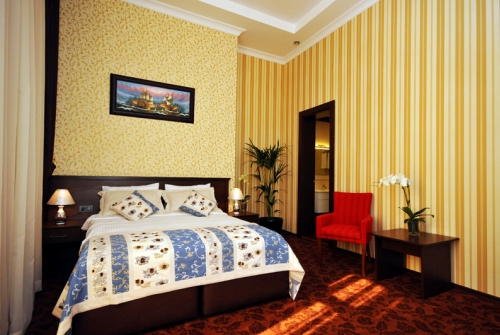
Central Park Hotel offers a comfortable stay right in the centre of Baku but in its own little quiet oasis. Located five minutes walk from the marvellous Fountains Square & the Nizami Promenade where world famous brand boutiques are waiting to tempt you and a brisk 20 minute walk brings you to the wonderful Boulevard with breath taking views of the Caspian Sea & exciting sky-line of Baku. Guests can choose from a range of bedroom styles within our 70 room hotel from standard single & doubles to luxury suites, including one offering presidential standards - all with balconies overlooking the Old Town. All rooms are equipped with plasma satellite TV, internet } connections (Wi-Fi) and some even have a Jacuzzi. You can have a relaxing drink in the lobby bar or enjoy a panoramic view of Baku from the Sky Bar before dining in our stunning Beluga Skyline Restaurant which offers a delicious international menu.

| Gabala | Qafqaz Sport | 3 Night(s) |
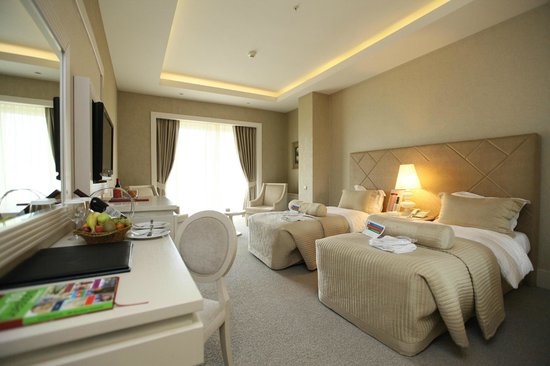
Featuring an indoor pool, a spa centre and gym, this 5-star hotel is located in Qabala city, at two minutes drive from city centre. It also offers free Wi-Fi in the rooms. Every air-conditioned room and cottage at Qafqaz Sport Hotel includes bright elegant d�cor with pastel tones and a minibar. Bathrooms with showers. The restaurant, decorated in beige colours, serves international cuisine & drinks are offered at the bar. Guests can relax on the sun terrace by the outdoor swimming pool or in the sauna. A Turkish steam bath, as well as beauty treatments, are provided in the spa centre.

| Baku | Central Park | 1 Night(s) |
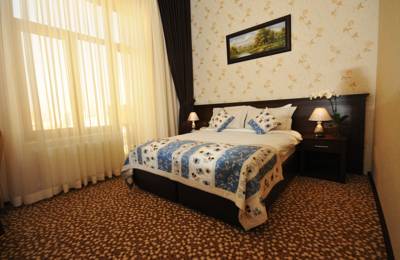
Central Park Hotel offers a comfortable stay right in the centre of Baku but in its own little quiet oasis. Located five minutes walk from the marvellous Fountains Square & the Nizami Promenade where world famous brand boutiques are waiting to tempt you and a brisk 20 minute walk brings you to the wonderful Boulevard with breath taking views of the Caspian Sea & exciting sky-line of Baku. Guests can choose from a range of bedroom styles within our 70 room hotel from standard single & doubles to luxury suites, including one offering presidential standards - all with balconies overlooking the Old Town. All rooms are equipped with plasma satellite TV, internet } connections (Wi-Fi) and some even have a Jacuzzi. You can have a relaxing drink in the lobby bar or enjoy a panoramic view of Baku from the Sky Bar before dining in our stunning Beluga Skyline Restaurant which offers a delicious international menu.

| Quba | Rixos Quba | 2 Night(s) |
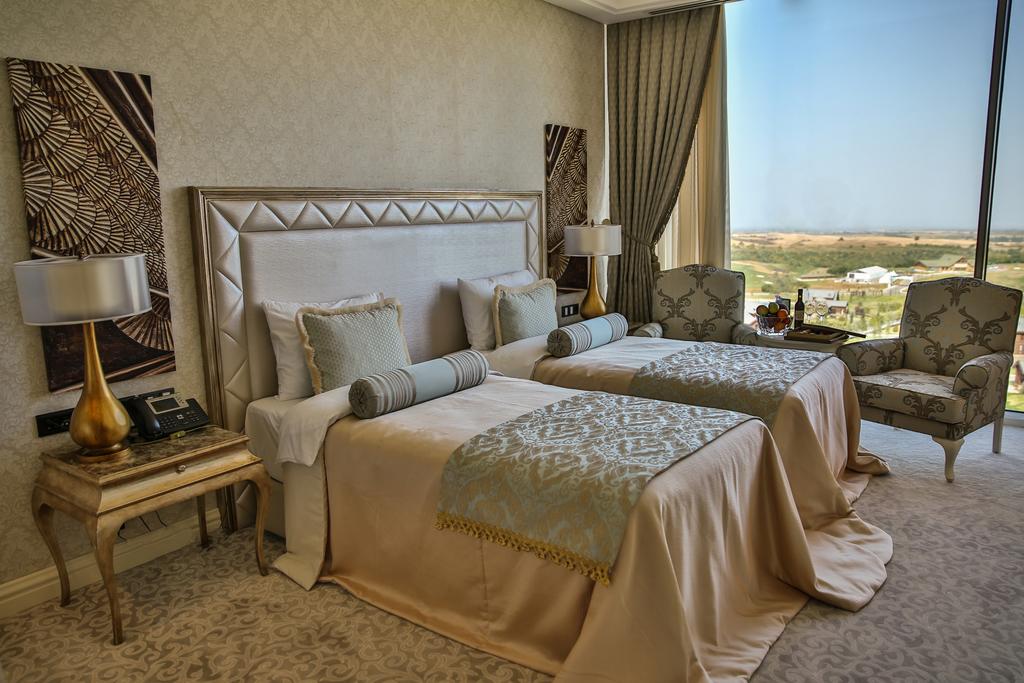
The Rixos Quba Azerbaijan offers a five-star holiday experience with snowy summits & emerald-green forests in the middle of the majestic nature of the Caucasus. Rixos Quba Azerbaijan offers an unforgettable holiday experience with its golf court, short distance to the ski resort, comfortable & luxurious rooms, suites & villas. Get ready and pack your suitcase for a perfect holiday, enjoying excellent restaurants, bars, SPA and more. Meeting all expectations, Rixos offers 212 rooms, suites & villas available in different categories. Enjoy your stay with the most distinctive dishes and beverages from around the world, relaxing SPA treatments, entertainment and the Rixy Club amongst the breathtaking backdrop of the Great Caucasus Mountains. While tasting the most distinguished dishes from the Turkish, Azerbaijani and international cuisine, enjoy our special beverages and our fine wine selection

| Baku | Central Park | 1 Night(s) |
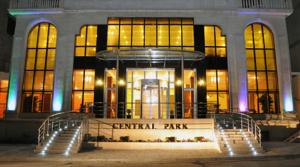
Central Park Hotel offers a comfortable stay right in the centre of Baku but in its own little quiet oasis. Located five minutes walk from the marvellous Fountains Square & the Nizami Promenade where world famous brand boutiques are waiting to tempt you and a brisk 20 minute walk brings you to the wonderful Boulevard with breath taking views of the Caspian Sea & exciting sky-line of Baku. Guests can choose from a range of bedroom styles within our 70 room hotel from standard single & doubles to luxury suites, including one offering presidential standards - all with balconies overlooking the Old Town. All rooms are equipped with plasma satellite TV, internet } connections (Wi-Fi) and some even have a Jacuzzi. You can have a relaxing drink in the lobby bar or enjoy a panoramic view of Baku from the Sky Bar before dining in our stunning Beluga Skyline Restaurant which offers a delicious international menu.

| Lankaran | Qafqaz Sahil | 3 Night(s) |
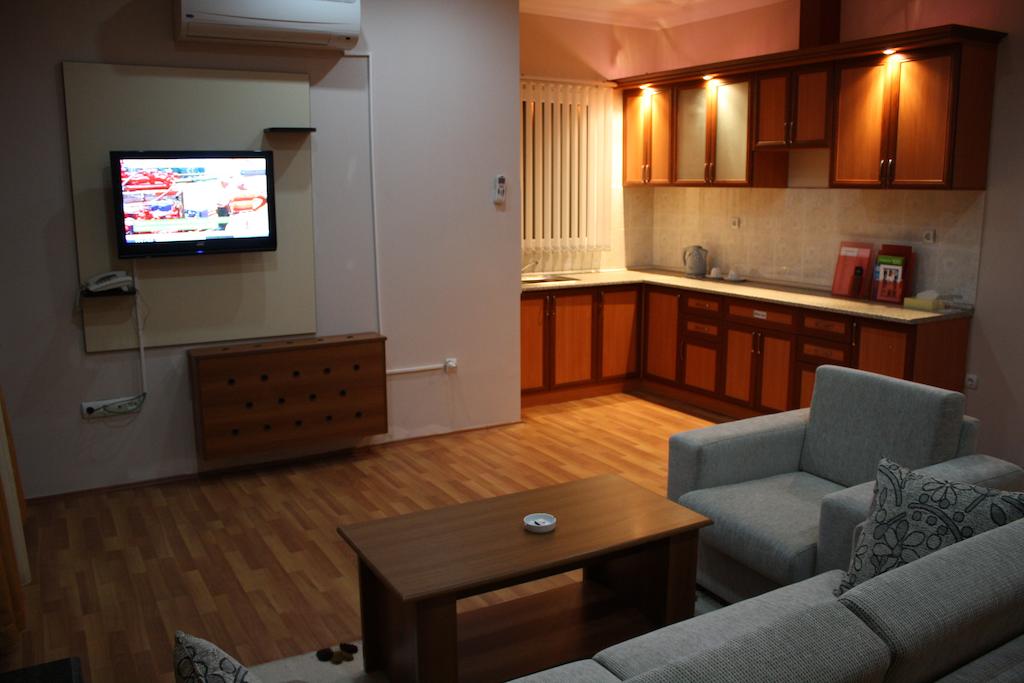
Qafqaz Sahil Lankaran is located in the centre of Lankaran & overlooks the sandy Caspian Sea coast. The elegant, air-conditioned rooms of the hotel have carpeted floors and classic-style furnishings. Each room comes complete with a flat-screen TV, a minibar and a private bathroom. All room overlook the sea. Offers free Wi-Fi, a fitness centre & a sauna. Guests can enjoy Azerbaijani & European cuisine in the restaurant. The bar offers a variety of drinks, including local wines. After a day of sunbathing or exploring the attractions of the old Lankaran city, guests can relax in the massage room or visit the beauty salon.

| Baku | Central Park | 1 Night(s) |

Central Park Hotel offers a comfortable stay right in the centre of Baku but in its own little quiet oasis. Located five minutes walk from the marvellous Fountains Square & the Nizami Promenade where world famous brand boutiques are waiting to tempt you and a brisk 20 minute walk brings you to the wonderful Boulevard with breath taking views of the Caspian Sea & exciting sky-line of Baku. Guests can choose from a range of bedroom styles within our 70 room hotel from standard single & doubles to luxury suites, including one offering presidential standards - all with balconies overlooking the Old Town. All rooms are equipped with plasma satellite TV, internet } connections (Wi-Fi) and some even have a Jacuzzi. You can have a relaxing drink in the lobby bar or enjoy a panoramic view of Baku from the Sky Bar before dining in our stunning Beluga Skyline Restaurant which offers a delicious international menu.

The Journeys has carefully selected each hotel based on overall quality, location, price, food, service & cleanliness. All rooms are standard rooms with two beds & private facilities, unless you have specifically requested and paid for an upgrade. Room selection is strictly at the discretion of the hotel management. We reserve the right to make hotel substitutions with those of equal standard due to non-availability of the selected hotels.
Check-in time is usually 2:00 pm or later. Check-out time is 12:00 noon. If you will be arriving early in the day or departing in the evening, hotels will usually allow you to store your luggage in their luggage room. We will ask at the front desk on your behalf, if the hotel can check you in earlier, or let you stay later.

Azerbaijan… prepare to be charmed…
And last but not least:
Departure:
Arrival in Baku on Any Day (minimum of 2 guests)
Validity:
→ December 2025
Prices:
We offer several accommodation choices for this tour. The price varies by selected accommodations. The itinerary remains unchanged.
Exchange rates fluctuate with great frequency. Please contact us for current Pricing and we will respond
within 24 hours.
|
Azerbaijani Kaleidoscope |
|||
|
Price Per Person - C$ |
Superior *** |
First Class **** |
Deluxe ***** |
|
Occupancy - Double |
On request |
On request |
On request |
|
Single |
On request |
On request |
On request |
|
Triple |
On request |
On request |
On request |
|
|
|||
|
Airfare - International |
On request |
On request |
On request |
|
|
|||
|
Miscellenous |
If required |
If required |
If required |
|
|
|||
|
|
|
|
|
.
Some important notes
- Flights are subject to constant modifications / delays and cancellations. In such cases, we will do all possible to find the best available alternative / solution but will not accept any liability, whatsoever.
- Our rates only include those items which are specified in the Itinerary / Inclusions.
- The cost has been calculated on the existing tariffs / conditions and in case of any currency fluctuations or amendment in local Government taxes, or any fuel hike, we reserve the right to revise the tour price accordingly.
- Our quotations are calculated on base category of accommodation at each property and are subject to modification, if the same hotel / category of room not available at the time of reservation. In that case, we will confirm a superior category of room at a comparable or better hotel and supplement charges, if any, shall be advised accordingly. Final Itinerary will illustrate updated information and / or it would be furnished at the time of confirmation.
- All prices are per person, based on double occupancy, and subject to availability at the time of booking. The from price reflects the lowest available price at time of publication, which is valid for a specific start date or dates and also based on availability at the time of booking.
- Room availability is getting saturated due to heavy demands from the tourism industry, international Fairs and Congresses. Due to these constant sold- out situations the hotels are applying the cancellation rules more stringently. Once the reservation is guaranteed, the booking will be subject to full cancellation charges as per our Terms & Conditions (details will be advised at the time of deposit). We strongly recommend obtaining Insurance to protect yourself against any unforeseen scenarios.
- Additional services including Optionals, if any, can be paid directly by the clients to our local offices.









